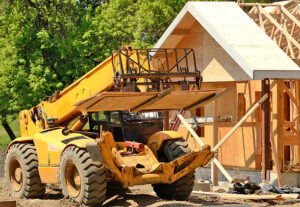
Imagine a machine that could do the work of a lift truck and aerial work platform, with the added benefit of a telescopic arm. Sounds neat and efficient, huh? You don’t have to imagine it! It exists. It’s called a telehandler, which is a portmanteau of the words “telescopic handler.”
What Exactly is a Telehandler?
A telehandler is a hydraulic lifting machine used to carry and place heavy materials. They’re able to lift and move loads from place to place much like a lift truck, but they have additional functionality to move loads with a crane-like tool called a boom. Operators can affix a variety of different attachments to the end of their boom to hold different materials. The attachment’s design suits the kind of load it’s built to carry, for example:
- Forks: These tines perform the same function as the forks on a lift truck. They’re used to carry pallets, raw materials, or piping.
- Crane Jibs: Telehandlers can function like cranes using a jib hook. This is helpful for carrying materials over and around obstacles.
- Buckets: These container-like attachments scoop loose materials like soil or sand.
- Work Cages: A work cage lifts workers. They’re sometimes called platforms and they enable the telehandler to function as an aerial lift. Special training is necessary when using a work cage, and working at heights training is mandatory.
Learn More about Safe Operation of a Telehandler Training
Why Use a Telehandler?
When there is a requirement for versatility and precision, the telehandler is the machine of choice. Telehandlers perform effectively and safely on even the most rugged terrain, and they are also a cost-effective choice.
- Versatility: Thanks to the ability to switch out attachments, you’re limited to one function when there’s a telehandler on site. Changing out attachments is easy for experienced operators, and that means that one machine can do the work of many throughout the day. While most machines are designed to very effectively carry out a very specific function, telehandlers thrive in environments that demand flexibility.
- Precision: A telehandler has better handling capability than a lift truck or aerial lift thanks in part to its telescopic boom. Operators can lift materials or transport them diagonally. This precision enables better and safer movement in confined spaces and around obstacles as well.
- Built for Rugged Terrain: Those of you who have taken lift truck and aerial work platform training know that operation on a smooth, even surface is a must for safety. Telehandlers can handle uneven footing and rugged outdoor landscapes because they’re built to leverage weight on all surfaces.
- Cost Effective: There’s a cost to running heavy machinery including the cost to rent and fuel the machines and hire and train competent operators. Using a telehandler to do the work of several machines will reduce those costs significantly.
Don’t Forget Safe Operation of a Telehandler and Working at Heights Training!
All workers who work from heights require training on how to use fall protection equipment, care and inspection, rescue procedures, and any other fall protection knowledge that may apply to the work. This includes any employee who will be lifted using a work cage! Operators should complete Working at Heights Training as well.
BEST Safety Training is a CPO-approved provider of Working at Heights (Construction, Industrial, and Refresher) training and Working at Heights Train-the-Trainer – Industrial.
Check out the training calendar to see courses in your area!
BEST Safety Training also offers Safe Operation of a Telehandler Training. We do practical evaluations too – we come to you!
Sign Up Today! Now Offering: Telehandler Theory + Practical Evaluation | November 10th, 2022 (In person – St. Thomas)
Not Sure Where to Start? BEST Safety Training Can Help
Download this FREE Telehandler 101 Safety Calendar, courtesy of BEST Safety Training and Consulting.
Like the calendar? Add your email to our mailing list to get one FREE, straight to your inbox, every month. Each month features a new topic, all designed to keep your workplace safe, healthy, and compliant.
See all onsite and virtual learning coming soon to your area!
To ask questions about our training programs or to book a consultation to help you develop a customized working at heights safety program contact us online or call 226.777.7385. Visit us 24/7 on the web at bestsafetytraining.ca.
